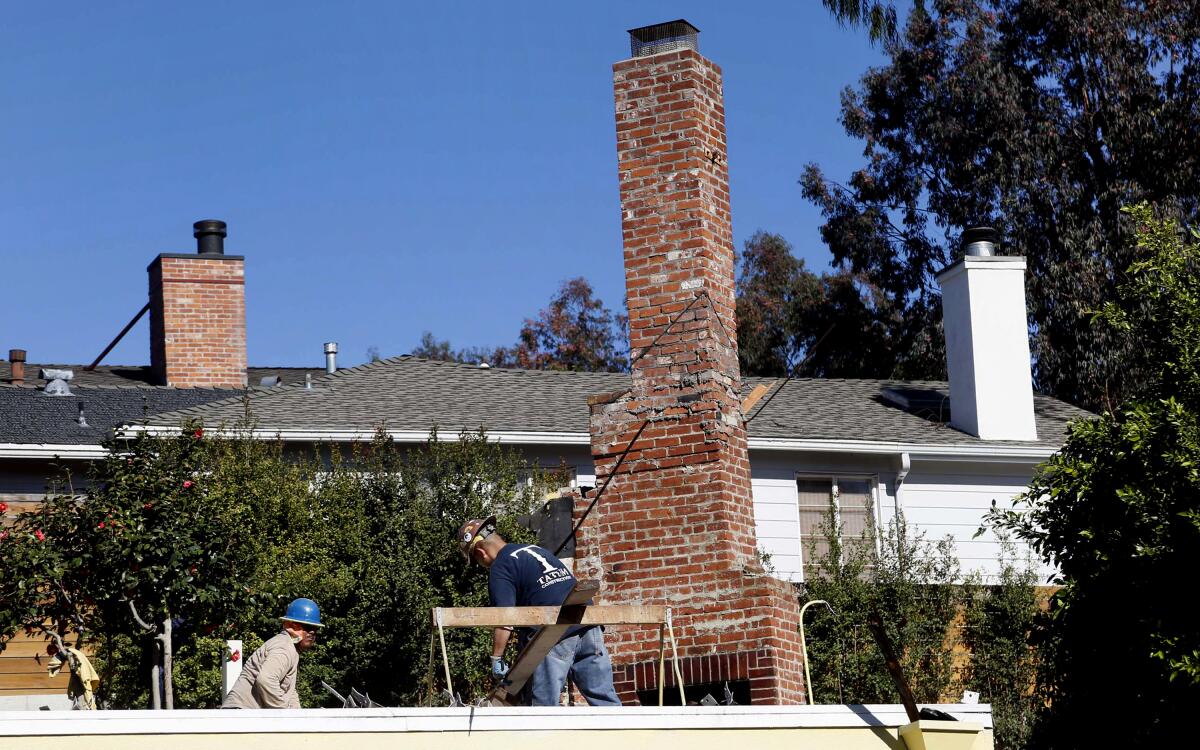L.A. lives its history. It doesn’t landmark it

- Share via
I used to live a few blocks from Raymond Chandler’s house. Or one of his houses, at any rate. Chandler — according to Judith Freeman’s geographic biography, “The Long Embrace” — had at least 35 Southern California addresses before he died in La Jolla in 1959. The place I’m describing was the 31st, and last in Los Angeles: 6520 Drexel Ave., walking distance from the Farmers Market. He and his wife, Cissy, rented it from 1944 to 1946.
The house is not much when it comes to literary achievement. Chandler wrote no books there, although he did complete a pair of essays (including his seminal examination of detective fiction, “The Simple Art of Murder”) and the screenplay for “The Blue Dahlia,” which he famously cranked out, by arrangement with the studio, under the influence of glucose injections and alcohol. None of that, though, really matters: Whenever I walked past 6520 Drexel, I felt I was getting close to history’s hidden residue.
Were Los Angeles another city — London, say, where since 1866 blue plaques have been affixed to buildings in which notable residents lived or worked — we might find a marker there. Instead, the house sits, like any in the neighborhood, set back from the curb behind a small front lawn, stucco with a red tile roof.
When I first moved to Southern California, such a lack of acknowledgment disturbed me; now, I find it exhilarating. What it tells us is that in this place, history takes on a different texture, not so much distinct, externalized, but woven subtly into the fabric of the everyday. This makes it ours to find.
I imagine Los Angeles history as less a guided tour and more an individual inventory we carry around in our heads. Understanding the city requires a kind of secret knowledge of what the writer Sam Sweet has called “lost heroes & miniature histories” that peel back the surface of the place and allow us to internalize the past.
Los Angeles, after all, has a complicated relationship with history. That’s something we take for granted. Landmarks get erased here, or overwritten. I think of another writer’s house, Ray Bradbury’s, in Cheviot Hills; he lived and worked there for 50 years. Then architect Thom Mayne bought it and tore it down in 2015.
Bradbury’s house, like Chandler’s on Drexel, was notable for what went on inside it; it was no masterpiece of design. The same holds for the places Sweet recalls. His pamphlet series, “All Night Menu,” highlights, for instance, Nudie’s Rodeo Tailors, formerly at 12318 La Maida St. in North Hollywood (made famous by Elvis Presley’s gold lame suit and Gram Parsons’ embroidered marijuana outfit), and the basement studio at 506 North Virgil Ave. where Jake Porter recorded local R&B performers for his label Combo.
That such spots are often forgotten — or at any rate not formally landmarked — makes it incumbent on us locals to remember, to stitch the overlapping narratives of the city into place.
My list of touchstones includes El Coyote, still in business on Beverly Boulevard, where Sharon Tate and the other Cielo Drive victims had their last meal on the night they were murdered by the Manson family. Also Greenblatt’s Deli on Sunset, where F. Scott Fitzgerald ate before his fatal heart attack, and the old Coronet Theatre on La Cienega Boulevard (reinvented now as the Largo at the Coronet), where Charles Laughton and Bertolt Brecht premiered the English-language version of Brecht’s play “Galileo.”
Brecht lived in Santa Monica from 1941 to 1947, part of the German exile community that included Thomas Mann and Arnold Schoenberg. Although I’ve never set foot inside Chandler’s place on Drexel, I did visit Brecht’s house once; the person who lived there invited me inside for a tour of the room in which the playwright wrote.
Did the experience offer any new insight into Brecht? Not especially. Like the rest of the house, the writer’s work space had been extensively renovated. But the fact that the owner and I acknowledged the history kept Brecht connected to Southern California, and us to the World War II emigre culture.
Southern California’s civic and literary history is relatively new, as such things go; when the first blue plaque went up in London, fewer than 5,000 people were living here. It’s been less than a lifetime since Brecht took up residence in Santa Monica. Chandler died 60 years ago, Bradbury in 2012.
What this means is that in this place history lingers at our fingertips, something we can easily, if at times unexpectedly, reach out and touch. It is vernacular in other words, not formal, asserting itself in the interstices, the houses and neighborhoods, the strip malls and restaurants we still use, where our ongoing heritage simply accrues.
David L. Ulin is a contributing writer to Opinion.
More to Read
A cure for the common opinion
Get thought-provoking perspectives with our weekly newsletter.
You may occasionally receive promotional content from the Los Angeles Times.









